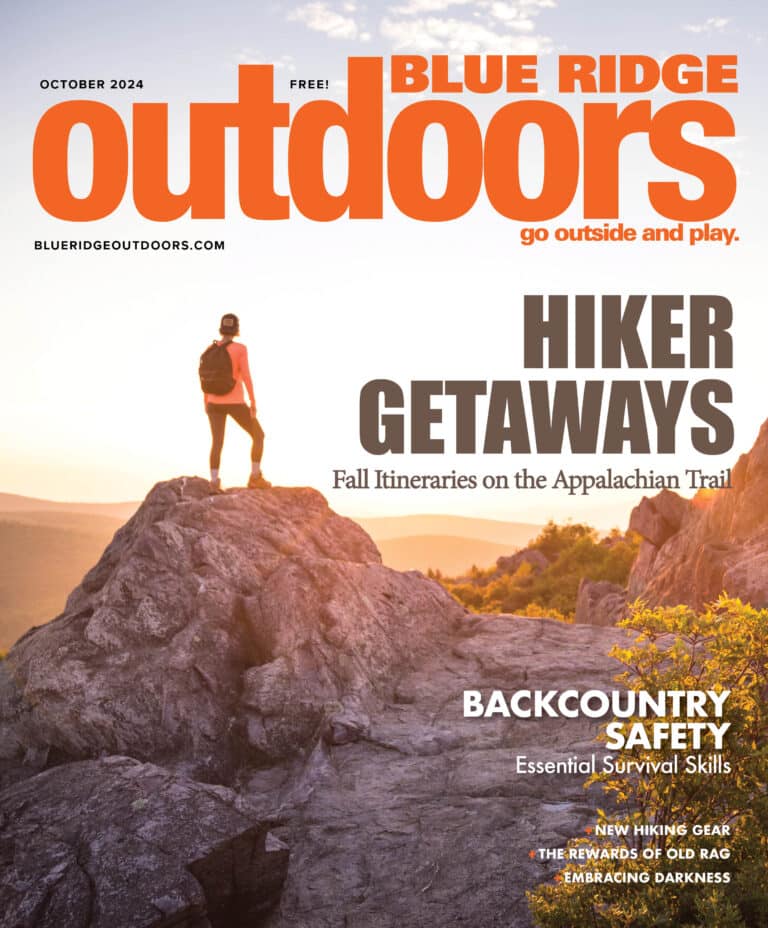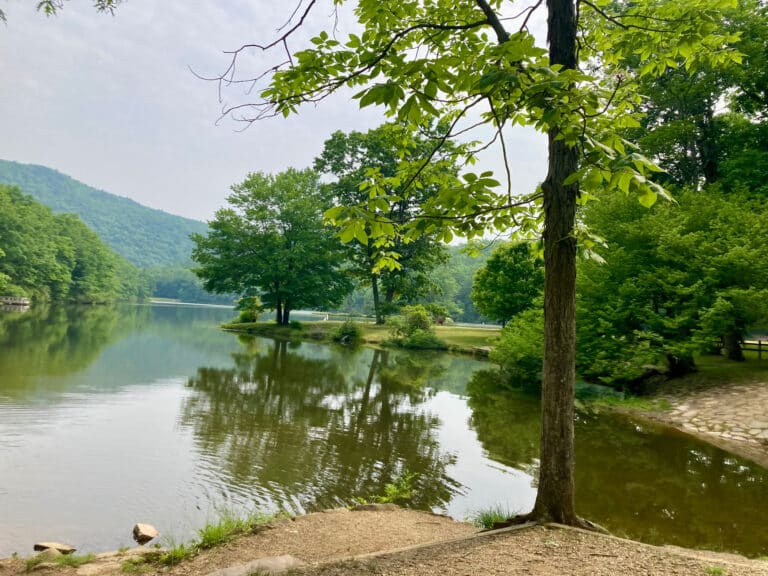After two decades spent section-hiking the Appalachian Trail, a retiree left a single mile untrodden for a celebration with his aging dad and friends. But with injuries and illnesses mounting, would everyone make it to the end?
“The beginning of the wilderness was tough,” says Bob Corradetti.
It was August of 2021, when he and three friends started backpacking from Monson, Maine, into the 100 Mile Wilderness. Each day, the hikers spread out along one of the most remote and rugged sections of the roughly 2,195-mile Appalachian Trail. Wearing heavy packs, they progressed past steep pitches, loose scree, tricky boulders, and jolting bedrock. When sporadic rains fell, the humidity felt suffocating, and the route became slippery.
On day five, Lou was feeling overheated, so he went ahead to collect water from a stream. Coming next was Ingrid, followed by Bob and Lynn. Each of them was a dedicated section hiker in various stages of completing the entire A.T. Forty miles into the wilderness, Bob had about 323 miles left, spread across five states.
“I took a regular step,” says Bob. “And I felt a sudden sharp pain and a snap.”
The 69-year-old Bob soon realized his week was over. It wasn’t the first time a section hike had ended early, usually due to weather. This time, he couldn’t put weight on his right knee without wincing. Fortunately, a day hiker heading out from Gulf Hagas had a vehicle nearby. Bob managed to limp a few miles down a side trail and catch a ride.
During his drive home, the injured Bob was distraught. As usual, Bob stopped at his dad’s house near the Delaware Water Gap. Nearby was a single mile of the A.T. that Bob had left untrodden. He planned to walk it last, so he could complete his section hike during a celebration with his dad and friends.
But Fred Corradetti was now 90 years old and struggling with his own health issues.
During a 20-year Navy career, he’d done plenty of mandatory training marches, including summiting Mt. Fuji in Japan. Now, Fred was an avid supporter of his son’s endeavor.
“I hope you can still finish the trail,” said Fred.
Bob hoped so, too. But with his knee aching, he was seriously wondering if he’d ever make it to that last mile.

From Steps to Seeds
“I didn’t understand why many hikers prefer uphill to downhill,” Bob says about when he began hiking the A.T. “I used to jump from boulder to boulder, but now I’m older and slower.”
Bob’s first experience on the A.T. came in 2005, at the age of 53, when a friend invited him on a three-day backpacking trip. Bob was a nurse at the University of Delaware, which allowed him time off during college breaks. He continued doing sporadic trips and eventually joined the Wilmington Trail Club, whose members focused on hiking the A.T. in Pennsylvania.
In 2013, Bob joined the neighboring Chester County Trail Club, which organized two-week trips to day-hike the southern portion of A.T. Each June, around 15 members rented a house near the trail. Every day, the group would focus on a different segment, about 10 miles in length. Half the group would park at the northern trailhead and hike south. The other half parked at the southern trailhead and hiked north. When everyone met in the middle, they exchanged keys and drove each other’s cars back to the house—just in time for cocktail hour.

In the club, Bob became friends with members like Lynn and Lou, whom he would eventually hike with for a thousand miles. It’s also how Bob earned his trail name: Waldo.
“In the beginning, I was pretty fast,” says Bob, who often waited for others to catch up.
During one club trip, he missed the connector trail and kept hiking. “Everyone is saying, ‘Where’s Bob?’ Later, I was getting so slow that I was always lagging behind. ‘Where’s Bob?’ kind of morphed into ‘Where’s Waldo?’”
By mid-2016, after three summer club trips, Bob had completed the southern end of the trail: about 390 miles between Springer Mountain in Georgia to near Roan Mountain, Tennessee. During other trips with club members, friends, and his son Jeff, Bob completed all of New Jersey’s 72 miles, Maryland’s 41 miles, and most of Pennsylvania’s 230 miles. That amounted to roughly a third of the entire trail, and the seed was planted. For the first time, hiking the entire Appalachian Trail seemed possible.

Easy Miles and Hard Knocks
“I thought I should tackle Virginia next,” says Bob. The triangular state has 550 trail miles, the most among the 14 states along the A.T. Given its southern location, Virginia seemed suitable for fall attempts.
On Thanksgiving Day in 2016, Bob, Jin, and Richard hiked north from Skyland in Shenandoah National Park. The weather and trail terrain were mild, and nearly 50 miles later they reached Front Royal on Sunday morning. Most of the state would not come so easy. The following Thanksgiving, Bob, Lynn, and Leslie met up north of Roanoke for a long weekend of day hikes. Then an ice storm closed the roads. So the hikers walked short sections of the A.T. and returned on the empty Blue Ridge Parkway, trudging through snow and fallen branches.
Bob’s retirement in September of 2018 allowed him to hike the following month with Lou and Jin. They went southbound on a steep section through Mount Rogers National Recreation Area. It was hot out when the remnants of Hurricane Michael arrived. At first, the steady rains felt refreshing. Then temperatures dropped into the 40s, and Lou went hypothermic. The trio hit the road just five miles from Damascus and put their thumbs out.
Other trips went better. The Grayson Highlands involved a breezy walk through mountain meadows, with longhorn cattle and wild ponies. Bob and his wife Reneé went back to Shenandoah National Park and day-hiked south of Skyland. He and friends did 75 miles northbound from Roan Mountain to just past Damascus, closing the five-mile gap they previously accrued. For that trip, they traveled with light packs and slept in hiker hostels.
In the north, it took Bob, Lynn, and Lou three summers to knock out New Hampshire’s 161 miles. The trail was challenging with rocky and steep sections, where ladder rungs of rebar were embedded in stone. Here they did the Appalachian Mountain Club’s hut-to-hut trip, each paying over $100 per night for a place to sleep, cold running water, and a hot dinner and breakfast.
Bob recorded his completed sections in a copy of the Appalachian Trail Thru-Hiker’s Companion, which he used to plan the next hikes. Gradually, he knocked off parts of Vermont and southern Maine until 2021. Then, just 323 miles short of completion, his right knee buckled, and he stumbled out of the 100 Mile Wilderness.

Progress and Doubts
Back home, Bob saw an orthopedist who believed it was only arthritis of the knee. Bob wasn’t convinced, but he welcomed the chance to continue. With the help of a cortisone shot and knee brace, he shrugged off the discomfort and was back on the trail six weeks later. After seven days in Vermont, moving slowly for 87 miles, the pain returned. Ultimately, Bob would need arthroscopic surgery to clean up a torn meniscus. He regretted not completing the tough northern sections years earlier, when he hiked ahead of the pack. If Bob wanted to finish, it was going to be a painful slog.
“People always say [to me] that your knees hurt because you did that stuff,” says Bob, explaining he doesn’t regret continuing. “I see people all the time in the store who can barely walk, and they never did the A.T.”
The summer of 2022 involved forward progress and further setbacks. Bob and Lou completed Connecticut’s 52 miles and New York’s 88 miles. Now Bob’s left ankle was hurting—an overuse injury from favoring the right knee. Returning to Maine, the two friends went southbound about 74 miles from Monson to Straton. Along the way, they crossed the Kennebec River by canoe ferry. At one point, Bob was descending a slick rock face. He grabbed a tree for support and pulled a muscle in his shoulder.
Late that July, they returned to the 100 Mile Wilderness. Completing the 60 miles past the access road took a week. When Bob reached Abel Creek, other than an easier 60-mile gap in Virginia, he had just 15 difficult miles remaining, the round-trip ascent of Mount Katahdin in Baxter State Park. But an aching Bob was being cautious, so he drove south with hopes that 2023 would be the year.
“What do you mean you’re having doubts,” said Fred, when his son visited to plan the Last Mile party. By now, Fred’s health was deteriorating, even as he happily anticipated attending the Last Mile party and a Navy reunion.
“You’re gonna finish,” said Fred. “If I gotta pull you up there myself.”

Mount Katahdin and the Last Mile
“Katahdin really kicked my ass,” says Bob, who did six weeks of PT to prepare.
When Bob and Lou picked up their permit in July of 2023, the ranger told them an average hiker takes 8-12 hours roundtrip. But they wouldn’t return for fifteen hours. On the ascent, they carefully negotiated loose slopes and large rocks. Upon reaching the boulder-strewn summit at 5,269 feet, there was little time to celebrate. Weather was rolling in, and they were exposed above tree line. The descent felt disturbingly slow, including a lengthy traverse of a landslide zone in the rain.
“I finally finish Katahdin,” thought Bob, as the sky flashed, and thunder rumbled. “And we’re going to get struck by lightning.”
Instead, the exhausted pair staggered into camp. Bob had done the math. He’d walked over five million steps in nineteen years. Now he could barely move, so Renee helped him climb into their motorhome.
“I was hurting,” says Bob, but then he laughs. “Lou came up with the rigor mortis scale. I was a nine and ten is the true rigor mortis.”

If Katahdin was Bob’s hardest hike, walking the last mile was the easiest. Two months later, 30 people joined him at the Kittatinny Point Visitor Center at the Delaware Water Gap. Renee, Jeff, and Bob’s daughter Dina were there. So were trail buddies like Lou, Leslie, and Jin. Club members came from Wilmington and Chester County. Together they strolled across the I-80 bridge over the Delaware River.
Afterward, the celebration moved to Pub 447. Other folks arrived with Fred, who brought his son an engraved crystal plaque. The full length of the A.T. changes every year, due to minor trail rerouting, so each section hiker’s final mileage is a little different. Bob put $2,190.40 on the bar, and the drinks flowed. During a speech, Bob shared his trail adventures with each guest present.
“I can’t remember the last time I had so much fun,” says Bob.
However, sad news soon followed. During the event, Fred sat at the center table, loving the chance to reminisce with family, friends, and A.T. hikers who had stayed at his house over the years. By the end, Fred felt fatigued and needed help rising from his chair. A month later, and a year before his Navy reunion, Bob’s dad passed away a few days short of his 93rd birthday.
“In retrospect, it was like a living wake,” Bob says, reflecting about the Last Mile party.
Bob initially thought the completion of his section hike meant the end of his A.T. days. But many of his friends had their own sections to complete, so the hiking continued. Bob was back on the trail with Lou when he finished in Damascus. Lynn ended at Harpers Ferry. Leslie at the James River.
“A lot of this trail,” he realizes. “I’ve done twice now.”
Cover photo: Bob and Lou atop First Peak of Bemis Mountain. all photos courtesy of Bob Corradetti.








